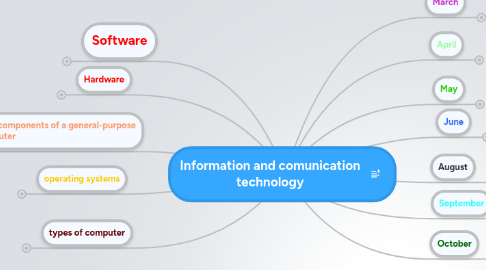
1. Hardware
1.1. Hardware is the physical parts of the computer system – the parts that you can touch and see.
1.1.1. A motherboard, a CPU, a keyboard and a monitor are all items of hardware.
1.2. Computer hardware is the physical components that make up the computer system. Hardware is useless without software to run on it.
2. Software
2.1. Software is instructions that tell computer hardware what to do. Software is useless unless there is hardware to run it on.
2.2. Software is a collection of instructions that can be ‘run’ on a computer. These instructions tell the computer what to do.
3. Main components of a general-purpose computer
3.1. Any data or instructions that are to be processed by the CPU must be placed into main memory (sometimes known as primary storage).
3.1.1. (CPU)Central Prossesing
3.1.1.1. The CPU is the 'brain' of the computer. It is the device that carries out software instructions.
3.1.1.1.1. The Pentium processor made by Intel is an example of a CPU.
3.1.2. main/internal memory
3.1.2.1. ROM
3.1.2.1.1. Random Access Memory (RAM) is the part of the computer that temporarily stores the instructions that the computer is running, and the data it is processing.
3.1.2.2. RAM
3.1.2.2.1. Read-Only Memory (ROM) is used in most computers to hold a small, special piece of software: the 'boot up' program.
3.1.3. input devices
3.1.3.1. Devices that pass data into the computer are known as input devices.
3.1.3.1.1. A keyboard, a mouse and a webcam are all examples of input devices.
3.1.4. output devices
3.1.4.1. Devices that take data from the computer are known as output devices.
3.1.4.1.1. A monitor, a printer and a loudspeaker are all examples of output devices.
3.1.5. secondary/backing storage
3.1.5.1. Secondary storage (sometimes called backing storage) is the name for all of the devices (apart from ROM and RAM) that can store data in a computer system.
3.1.5.1.1. A hard drive, a CD-ROM, a floppy disc and a USB memory stick are all examples of secondary storage devices.
4. types of computer
4.1. personal computer (PC) or desktop
4.1.1. The early 1980s saw a revolution in computing: The creation of computers that were small enough to fit on a desk, and cheap enough that everyone could have their own, personal computer, instead of having to share access to a mainframe.
4.1.1.1. These computers came to be known as desktop computers, or personal computers (PCs).
4.2. mainframe
4.2.1. A mainframe computer is a large computer, often used by large businesses, in government offices, or by universities.
4.2.1.1. Powerful - they can process vast amounts of data, very quickly
4.2.1.2. Large - they are often kept in special, air-conditioned rooms
4.2.1.3. Multi-user - they allow several users (sometimes hundreds) to use the computer at the same time, connected via remote terminals (screens and keyboards)
4.3. laptop
4.3.1. A 'laptop' computer is a light, compact and portable PC.
4.3.1.1. Laptops contain a rechargeable battery so that they can be used even when not plugged in to a mains power supply. They also have a built-in LCD monitor.
4.4. palmtop
4.4.1. A palmtop computer is similar to a laptop computer, but smaller. It's small enough to fit in the palm of your hand (hence the name!)
4.4.1.1. Palmtops are usually not very powerful since fast CPUs require a large battery and get hot - both problems in a small device.
4.5. personal digital assistant (PDA)
4.5.1. A PDA is similar to a palmtop computer, except it is even more compact, and typically has no keyboard, using a touchscreen for all data input. Since the screen is so small, many PDAs have a small stylus (plastic stick) that is used to press things on the screen.
4.5.1.1. Most PDAs use some sort of handwriting-recognition system to allow the user to write on the screen, and have their writing converted into text.
5. operating systems
5.1. graphic user interface (GUI)
5.1.1. A GUI is an interface built around visual (graphical) things
5.1.1.1. Windows are regions of the screen used to display information
5.1.1.2. Icons are small pictures that are used to represent folders, software, etc.
5.1.1.3. Menus are lists of options the user can select from
5.1.1.4. A pointer is an arrow that can be moved around the screen and is used to select things
5.2. command-line interface
5.2.1. Many years ago when computers were not very powerful they could not display the colourful graphics required for a GUI. The only interface available to most computer uses was the ‘command line’.
